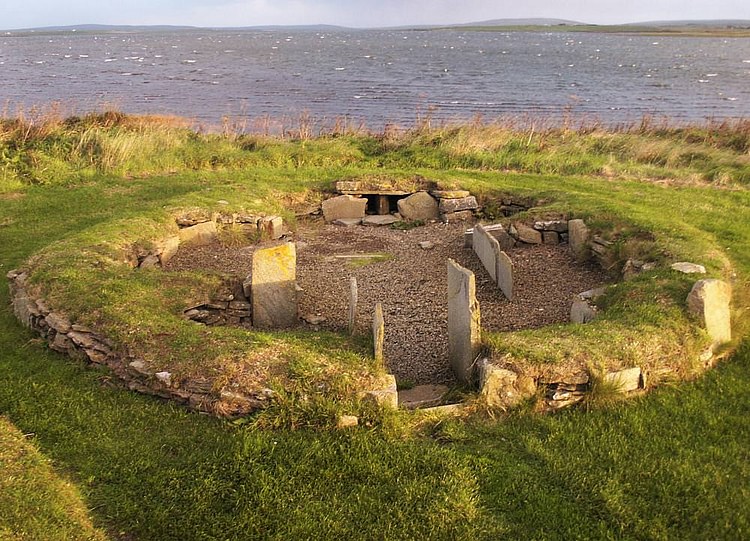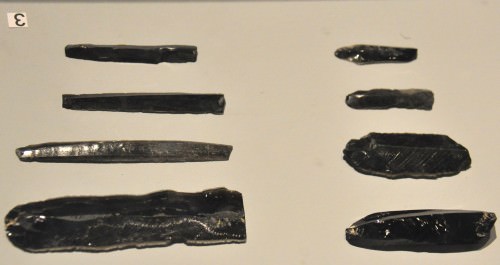Neolithic Period › Ancient History
Neolithic Period
DEFINITION AND ORIGINS

The term Neolithic Period refers to the last stage of the Stone Age - a term coined in the late 19th century CE by scholars which covers three different periods: Palaeolithic, Mesolithic, and Neolithic. The Neolithic period is significant for its megalithic architecture, the spread of agricultural practices, and the use of polished stone tools.
CHRONOLOGY
The term Neolithic or New Stone Age is most frequently used in connection with agriculture, which is the time when cereal cultivation and animal domestication was introduced. Because agriculture developed at different times in different regions of the world, there is no single date for the beginning of the Neolithic. In the Near East, agriculture was developed around 9,000 BCE, in Southeast Europe around 7,000 BCE, and later in other regions. Even within a specific region, agriculture developed during different times. For example, agriculture first developed in Southeast Europe about 7,000 BCE, in Central Europe about 5,500 BCE, and Northern Europe about 4,000 BCE. In East Asia, the Neolithic goes from 6000 to 2000 BCE.
THE DEVELOPMENT OF NEOLITHIC CULTURE APPEARS TO HAVE BEEN A GRADUAL RATHER THAN A SUDDEN CHANGE.
Pottery is another element that makes the dating of the Neolithic problematic. In some regions, the appearance of pottery is considered a symbol of the Neolithic, but this notion makes the term Neolithic even more ambiguous, since the use of pottery does not always occur after agriculture: in Japan, pottery appears before agriculture, while in the Near East agriculture pre-dates pottery production.
All these factors make the starting point of the Neolithic somewhat fuzzy. It should be remembered that the origin of the term lies in a late 19th century CE classification system (detailed above) and we must keep in mind its limitations.
A REVOLUTION?
In order to reflect the deep impact that agriculture had over the human population, an Australian archaeologist named Gordon Childe popularized the term “Neolithic Revolution” in the 1940s CE. However, today, it is believed that the impact of agricultural innovation was exaggerated in the past: the development of Neolithic culture appears to have been a gradual rather than a sudden change. Moreover, before agriculture was established, archaeological evidence has shown that there is usually a period of semi-nomadic life, where pre-agricultural societies might have a network of campsites and live in different locations according to how the resources respond to seasonal variations. Sometimes, one of these campsites might be adopted as a basecamp; the group might spend the majority of time there during the year exploiting local resources, including wild plants: this is a step closer to agriculture. Agriculture and foraging are not totally incompatible ways of life. This means that a group could perform hunter-gatherer activities for part of the year and some farming during the rest, perhaps on a small scale. Rather than a revolution, the archaeological record suggests that the adoption of agriculture is the result of small and gradual changes.

Obsidian Tools
Agriculture was developed independently in several regions. Since its origin, the dominant pattern in these separate regions is the spread of agricultural economies and the reduction of hunting and gathering activities, to the point that today hunting economies only persist in marginal areas where farming is not possible, such as frozen arctic regions, densely forested areas, or arid deserts.
Major changes were introduced by agriculture, affecting the way human society was organized and how it used the earth, including forest clearance, root crops, and cereal cultivation that can be stored for long periods of time, along with the development of new technologies for farming and herding such as plows, irrigation systems, etc. More intensive agriculture implies more food available for more people, more villages, and a movement towards a more complex social and political organization. As the population density of the villages increase, they gradually evolve into towns and finally into cities.
DEVELOPMENTS DURING THE NEOLITHIC
By adopting a sedentary way of life, the Neolithic groups increased their awareness of territoriality. During the 9600-6900 BCE period in the Near East, there were also innovations in arrowheads, yet no important changes in the animals hunted were detected. However, human skeletons were found with arrowheads embedded in them and also some settlements such as Jericho were surrounded with a massive wall and ditch around this time. It seems that the evidence of this period is a testimony of inter-communal conflicts, not far from organized warfare. There were also additional innovations in stone tool production that became widespread and adopted by many groups in distant locations, which is evidence for the existence of important networks of exchange and cultural interaction.

Neolithic Variscite Necklace
Living in permanent settlements brought new ways of social organization. As the subsistence strategies of Neolithic communities became more efficient, the population of the different settlements increased. We know from anthropological works that the larger the group, the less egalitarian and more hierarchical a society becomes. Those in the community who were involved in the management and allocation of food resources increased their social importance. Archaeological evidence has shown that during the early Neolithic, houses did not have individual storage facilities: storage and those activities linked to food preparation for storage were managed at village level. At the site of Jarf el Ahmar, in north Syria, there is a large subterranean structure which was used as a communal storage facility. This construction is in a central location among the households and there is also evidence that several rituals were performed in it.
TOWARDS THE END OF THE NEOLITHIC ERA, COPPER METALLURGY IS INTRODUCED, WHICH MARKS A TRANSITION PERIOD TO THE BRONZE AGE.
Another site in northern Syria named Tell Abu Hureyra, displays evidence for the transition from foraging to farming: it was a gradual process, which took several centuries. The first inhabitants of the site hunted gazelles, wild asses and wild cattle.Then, we see evidence of change: gazelle consumption dropped and the amount of sheep consumption rose (wild in the beginning and domesticated in the end). Sheepherding turned into the main source of meat and gazelle hunting became a minor activity. Human remains show an increase of tooth wear of all adults, which reflects the importance of ground cereal in the diet. It is interesting that once pottery was introduced, tooth wear rates decreased, but the frequency of bad teeth increased, which suggests that baked food made from stone-ground flour was largely replaced by dishes such as porridge and gruel, which were boiled in pots.
THE END OF THE NEOLITHIC
Towards the end of the Neolithic era, copper metallurgy is introduced, which marks a transition period to the Bronze Age, sometimes referred to as the Chalcolithic or Eneolithic Era. Bronze is a mixture of copper and tin, which has a greater hardness than copper, better casting properties, and a lower melting point. Bronze could be used for making weapons, something that was not possible with copper, which is not hard enough to endure combat conditions. In time, bronze became the primary material for tools and weapons, and a good part of the stone technology became obsolete, signalling the end of the Neolithic and thus, of the Stone Age.
LICENSE:
Article based on information obtained with permission from the Website Ancient History EncyclopediaContent is available under License Creative Commons: Attribution-NonCommercial-ShareAlike 3.0 Unported. CC-BY-NC-SA License
Article based on information obtained with permission from the Website Ancient History Encyclopedia
Content is available under License Creative Commons: Attribution-NonCommercial-ShareAlike 3.0 Unported. CC-BY-NC-SA License